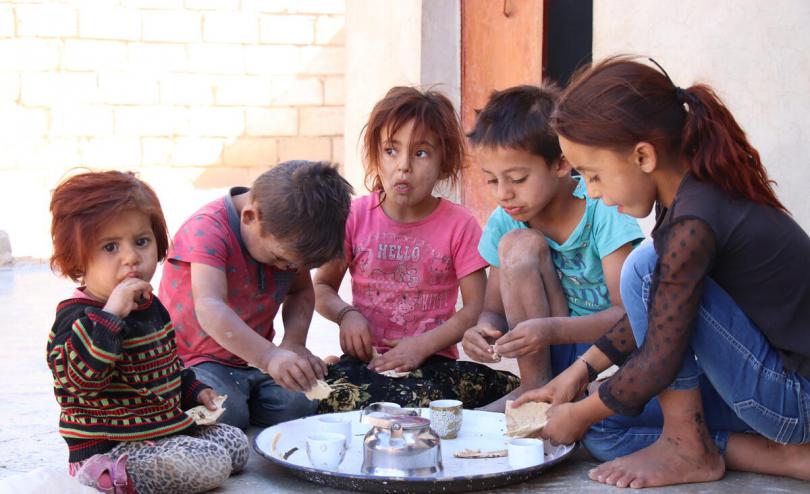North East Syria: Child malnutrition increases over 150% amid worsening hunger crisis

AMMAN, 10 November 2022- The number of malnourished children in North East Syria has surged by over 150% in the past six months with at least 10,000 more children now facing malnutrition than in the previous six months, according to new data[i].
The news comes as Syria faces its worst economic crisis since the start of the war in 2011 with 90% of the 18 million strong population living in poverty (UN)[ii].
Save the Children staff reported a fourfold increase – from 256 to over 1000 - in the number of malnourished children screened in its 19 nutrition centres in camps in North East Syria and in community settings, confirming the same worsening trend[iii].
Save the Children’s Nutrition specialist Sara Ali* said:
‘’Every day we have to deal with more malnourished children than the day before. Malnutrition is life threating to children. Poverty and the inability to afford food are the main reasons families are giving for this increase.”
Over the past three years, the combination of conflict, drought, the Lebanese financial crisis, and the COVID-19 pandemic have caused a free-fall of the Syrian currency to historically low levels.
While the average family income has not increased, food prices skyrocketed by almost 800% between 2019 and 2021[iv] and continue to rise in 2022[v].This massive price hike is forcing an ever-increasing number of people to go hungry.
Maha*, 30, works as a waste scavenger and is struggling to make ends meet to feed her five children, including her youngest Ameen*, who is malnourished.
“The war brought extreme hunger with it. Before we never had to worry about food being available despite being poor back then too.
‘’Sometimes we skip meals to save something to eat for the next day. I cannot remember the last time my children had meat or sweets. Sometimes they crave meat and ask me to get them some. I lie to them saying that I will the next day. I never do. They will have nothing to eat if I do. Our breakfast is always tea and bread only’.”
Beat Rohr, Interim Syria Response Office Director, said:
’“After almost 12 years of conflict in Syria, the worsening economic situation has become the main driver of needs, despite continued armed conflict in many parts of the country. At least 60% of the population is currently food insecure, and the situation is getting worse by the day.”
Save the Children is calling on donors to step up efforts to tackle the hunger crisis and alleviate its devastating impacts on children. While different organisations are working to provide food to the most vulnerable groups, the resources available are not sufficient to assure all children have access to balanced nutrition that is essential for their health and growth. The international community must urgently increase the availability of sufficient food to the most affected populations.
Save the Children is also calling on leaders gathering in Egypt for the COP27 climate change summit to recognise the climate impacts already affecting communities and children across the world, like the drought in North East Syria, particularly those from low-income countries and those who are affected by inequality and discrimination. Read more on our specific asks here.
Save the Children has been working in Syria since 2012, reaching over five million people, including more than three million children across the country. Save the Children’s programming combines emergency & life-saving interventions with early recovery activities that support the restoration of basic services, including child protection, education, emergency response, food security and livelihoods, water sanitation and hygiene as well as health and nutrition.
ENDS
*name changed to protect anonymity
Notes to Editors
- At least one in three children under 5 globally is affected by malnutrition in its most visible forms: stunting, wasting and overweight. Children affected by stunting – some 144 million under the age of 5 – are too short for their age, and their brains may never develop to their full cognitive potential, hindering their ability to learn as children, earn as adults, and contribute fully to their societies. Wasting affects 47 million children globally. Children with wasting are desperately thin, have weakened immune systems, and face an increased risk of death: They require urgent treatment and care to survive (UNICEF).
- In Syria, Save the Children’s Nutrition programme focuses on Infant and Young Children Feeding in Emergencies (IYCF-E) interventions, promoting, protecting and supporting recommended infant and young child feeding practices for both the prevention and treatment of malnutrition. Fresh food supplements aim to increase the access of pregnant and lactating women and children to a nutritious diet and reduce the risk of micronutrient deficiencies.
- The Nutrition sector in the Syria humanitarian Plan for 2022-2023 remain less than 11% funded as of October 2022 (OCHA).
- About 5.5 million people across Syria will need direct nutrition assistance in 2022-2023, half of them in North East Syria (WHO)
- An additional 5.5 million food insecure people were recorded[1] bringing the total to 12.4 million – about 60% of the country’s population.
- The number of severely food insecure people has more than doubled from 135 million to 345 million since 2019[vi]. 222 million of these people are facing acute hunger (IPC 3), the highest number since records began[vii].
- Around 45 million people in 37 countries are projected to have so little to eat that they will be severely malnourished, at risk of death or already facing starvation and death[viii]
- Worldwide, at least 13.6 million children under 5 are suffering from severe acute malnutrition[ix].
[i] 16,895 from April to September 2022 vs 6,650 from October 2021 to March 2022, according to data by the Nutrition cluster
[ii] https://reliefweb.int/report/syrian-arab-republic/secretary-general-urges-security-council-expand-aid-access-syria-renew-resolution-2585-2021-cross-border-operations-moral-imperative
[iii] This increase may be partially due to a community outreach campaign that was conducted.
[iv] Ramadan in Syria: Rising food prices push basics out of reach | World Food Programme (wfp.org)
[v] https://docs.wfp.org/api/documents/WFP-0000142857/download/
[vi] https://docs.wfp.org/api/documents/WFP-0000136949/download/?_ga=2.38257059.1286388886.1655649581-696087419.1654696734&_gac=1.53007706.1655131682.Cj0KCQjwwJuVBhCAARIsAOPwGAR6HTdtzBUarxdtlgky7kxr8o4Le-5lBK646IuCIgQWGO6twAK_hwwaArrrEALw_wcB
[vii] Hunger Hotspots: FAO-WFP early warnings on acute food insecurity, October 2022 to January 2023 Outlook - World | ReliefWeb
[viii] Hunger Hotspots: FAO-WFP early warnings on acute food insecurity, October 2022 to January 2023 Outlook - World | ReliefWeb
[ix] World a ‘virtual tinderbox’ for catastrophic levels of severe malnutrition in children (unicef.org)
For further enquiries please contact:
Emily Wight, Emily.Wight@savethechildren.org;
Randa Ghazy, Randa.Ghazy@savethechildren.org;
Our media out of hours (GMT) contact is media@savethechildren.org.uk / +44(0)7831 650409
Please also check our Twitter account @Save_GlobalNews for news alerts, quotes, statements and location Vlogs.




